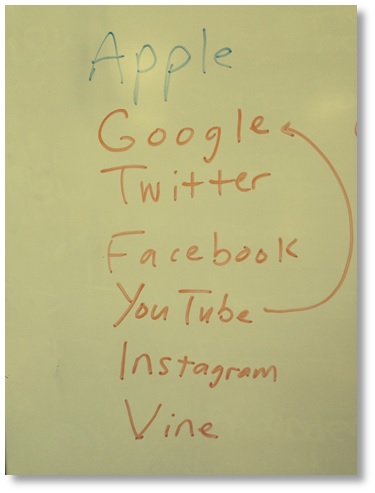
Recently, I served as "teacher for the day" in my daughter's fifth grade classroom. My guest appearance was coordinated by a great organization,
Junior Achievement, who "teaches young people about money management and how business works."
With a lesson plan provided by Junior Achievement, I taught five, 45-minute lessons on topics related to business and entrepreneurship. I know about raising fifth graders from the one I have at home, but spending a day with a class full of them gave me further insights on their attitudes and inclinations.
Before long, these fifth grade students will grow up and become part of the target audience for your marketing. Here are five
surprising marketing tips based on my observations.
1) Forget about social media marketing.
I asked students to name examples of businesses. Here’s the list compiled by this Silicon Valley-based class:

Perhaps they were too young to name
Snapchat? The point is, fifth graders are on the bleeding edge of technology. They used iPods as toddlers, then graduated to iPads. They may not be using Facebook, but their siblings and parents are. So they’re aware of what it is and what it does.
That being said,
forget about the social media marketing you’re doing today to reach their parents. Once these kids enter the workforce, social marketing will no longer be relevant, because another form of advertising will have emerged.
2) Invest in billboard advertising.

Photo source: Eric Fischer on
flickr.
We did a lesson on advertising. The fifth graders were given a business scenario and asked to work in teams to devise a business, then create an advertisement for that business. Before they started designing, they were asked to name
examples of advertising.
Many of the students mentioned billboard ads that they see on Highway 101 in the Bay Area. They were able to recall the messaging contained on those billboards in impressive detail.
Out-of-home advertising works! It's effective because of the captivated audience it commands. So as these fifth graders grow into adults, think of ways your own marketing content can be delivered to a captivated audience.
3) Decrease your online marketing budget.
If you think about standing up in front of a fifth grade classroom for an entire day, it can be worrisome: will the students have any interest in what I'm saying? To be honest, I noticed that some of them "tuned out" during segments of the lessons.
But what got them to
pay attention, engage and interact? Activities. The Junior Achievement lesson plans pair verbal instruction with a fun activity that reinforces that instruction.
Online marketing is great. It's
cost effective and it's measurable. But to make a deeper connection with your marketing, consider programs that include face-to-face interactions. The fifth graders are kind of expecting it.
4) Tomorrow’s workers won’t be motivated by gamification.
Many of the day's activities came in the form of games. The fifth graders would high-five each other when they rolled a six, but what got them most excited were forms of peer-to-peer connections and recognition.
WHITE PAPER: How Community Managers Can Use Gamification to Create Sustainable Engagement
We did an exercise in which two students were named partners in a popcorn and ice cream business. The two partners stood at the front of the classroom. Next, they called up classmates (one by one), assigning them to assorted roles within the business (delivery people, business analysts, attorneys and ultimately, a CEO).
Students were most excited when they were called up to the front of the room. The selection and "job assignment" (in front of the entire class) gave meaning to the activity. It
made them feel rewarded. How do you "gamify" experiences for tomorrow’s workers? Make it less about points and badges and more about peer-to-peer relationships and recognition.
5) Make them wait for it.

Photo source: User nooccar on
flickr.
Today’s generation of kids live in a world of
instant gratification. With timeshifting and on-demand consumption, they get what they want, when they want it. Remember how Thursday nights on NBC were called "Must See TV?" Today’s generation calls it "I See TV" ("When I Want It").
So first, make your product, content and experiences great. Then,
act differently with it. Don’t give it to them right away. Make them wait. Make them go through hoops to get it. Why? Because when they do, they'll cherish it. They’re so used to getting everything right away, that making them wait adds to the enjoyment.
Wrapping Up
Today’s fifth graders are tomorrow's customers. While I enjoyed my time in the classroom, I also considered it a form of market research, in better understanding tomorrow's buyers. Hopefully, I learned from them as much as they learned from me. And, I hope this post served to spur forward-looking thoughts on how to do marketing in the future.